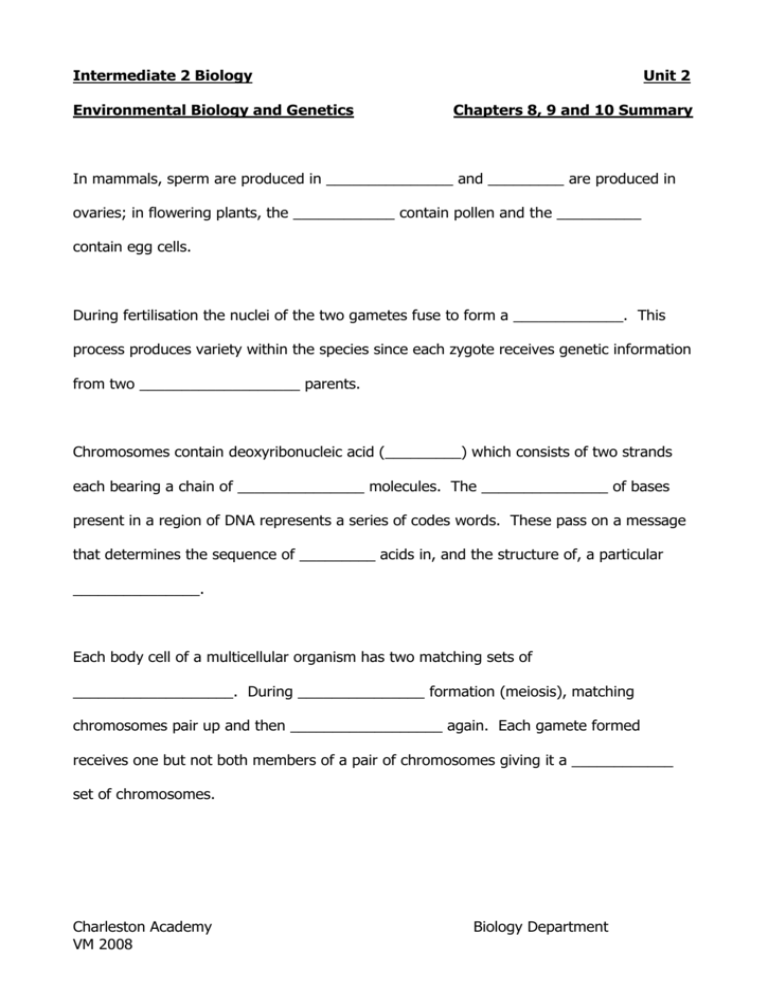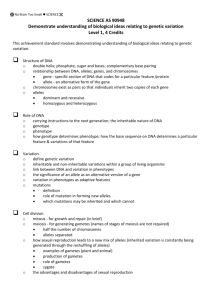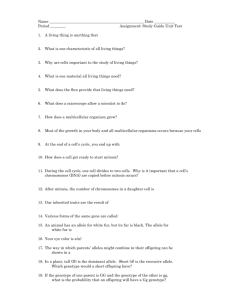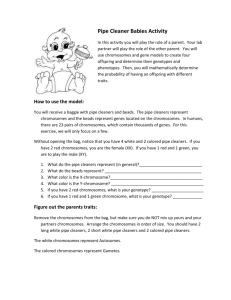Intermediate 2 Biology
advertisement

Intermediate 2 Biology Environmental Biology and Genetics Unit 2 Chapters 8, 9 and 10 Summary In mammals, sperm are produced in _______________ and _________ are produced in ovaries; in flowering plants, the ____________ contain pollen and the __________ contain egg cells. During fertilisation the nuclei of the two gametes fuse to form a _____________. This process produces variety within the species since each zygote receives genetic information from two ___________________ parents. Chromosomes contain deoxyribonucleic acid (_________) which consists of two strands each bearing a chain of _______________ molecules. The _______________ of bases present in a region of DNA represents a series of codes words. These pass on a message that determines the sequence of _________ acids in, and the structure of, a particular _______________. Each body cell of a multicellular organism has two matching sets of ___________________. During _______________ formation (meiosis), matching chromosomes pair up and then __________________ again. Each gamete formed receives one but not both members of a pair of chromosomes giving it a ____________ set of chromosomes. Charleston Academy VM 2008 Biology Department The separation of the members of a pair of chromosomes during meiosis occurs ___________ of the separation of all other pairs. This ‘shuffling’ of chromosomes leads to _____________ in the gametes and in the offspring produced. Each body cell of a human _______________ contains two X chromosomes; each body cell of human male contains one X and one ___ chromosome. All human eggs receive an X chromosome; half of the sperm receive an X and half a Y chromosome. The sex of a human individual is ________________ by the type of ______ that fertilises the egg. An organism’s physical characteristics are known collectively as its _________________; an organisms characteristics are determined by _____________ information received from both of its _________________. Each inherited characteristic is controlled by one or more units of heredity called __________; each gene is part of a chromosome. Each gene normally has two or more different forms called _____________. An allele that always shows its effect and masks the presence of the other form is said to be _______________; an allele that is masked by the dominant form is said to be _________________. Each gamete carries only one allele of a gene; each zygote formed at _________________ receives two alleles for each gene, one from each parent. Charleston Academy VM 2008 Biology Department The complete set of genes possessed by an organism is called its ___________________. The genotype of an organism with identical alleles of a gene is described as ____________________; the genotype of an organism with two different alleles of a gene is described as _________________________. An experimental cross involving one difference between two true-breeding parents is called a _______________________ cross. All members of the F1 generation resembles the parent with the dominant allele. Selfing of the F1 produces an F2 generation with a phenotypic _________ of 3:1. An organisms phenotype is a result of the interaction between its genotype and the __________________. Differences in phenotype caused by differences in genotype are ______________ and passed on from generation to generation. Differences in phenotype caused by environmental factors are not passed on to the next ___________________. Those members of species that are better ______________ to the environment survive to _______________ age and pass on the ________________ characteristics to succeeding generations; those members less well suited fail to do so. This survival of the ‘fittest’ in each generation is called ______________ selection. Charleston Academy VM 2008 Biology Department Genetic ______________________ allows pieces of DNA to be cut out of one organism and be __________________ into another organism which then forms a substance new to that species. __________________ bacteria can be used as chemical _______________ to produce useful products such as human ______________. Unlike selective __________________ genetic engineering allows scientists to alter an organisms genotype ___________________ so that it will produce exactly what is required immediately. adapted alleles amino anthers base breeding chromosomes determined different directly DNA dominant eggs engineering environment factories female fertilisation gametes generation genes genotype heterozygous homozygous independently inherited inserted insulin monohybrid natural ovaries parents phenotype protein ratio recessive reproductive reprogrammed separate sequence single sperm testes variety Y zygote Charleston Academy VM 2008 Biology Department favourable









